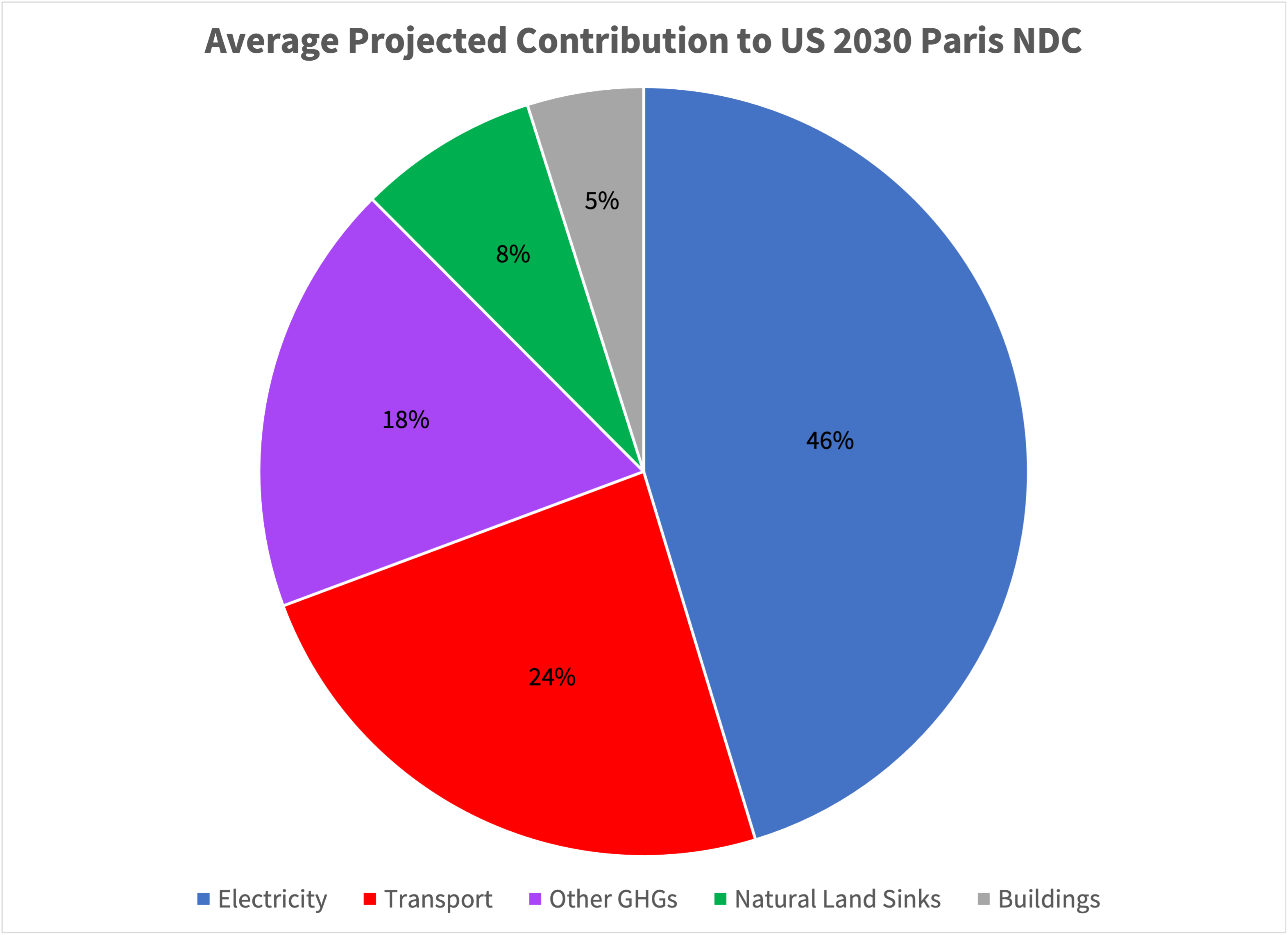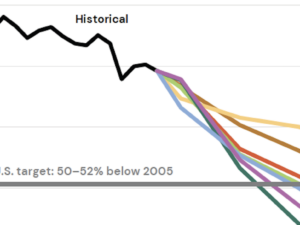CCL’s advocacy is properly directed to meet America’s Paris commitment
By Dana Nuccitelli
In April 2021, the Biden administration pledged to meet America’s share of the global Paris climate target by cutting our greenhouse gas emissions 50% below 2005 levels by 2030. CCL reiterated our support for that pledge last month, noting, “CCL strongly believes the climate goals laid out by the Administration to reduce emissions 50% by 2030 must be met.”
With two-thirds of the time between 2005 and 2030 having elapsed, national emissions today are only about 17% lower than 2005 levels. Most energy systems models project that under current policies, the U.S. will fall more than halfway short of our Paris commitment.
A new study in the prestigious journal Science used seven energy systems model scenarios to assess what it would take for America to accelerate our emissions cuts and meet our 2030 pledge. In short, success would require efforts to dramatically accelerate the deployment of solar panels, wind turbines, electric vehicles (EVs), trees, heat pumps, insulation, and measures to significantly curb the emissions of other potent greenhouse gases like methane. Fortunately, CCL is advocating for the exact policies needed to meet the U.S. Paris commitment.
What it will take to meet America’s Paris commitment
For details regarding how the new study envisioned that America could meet its Paris pledge, see my article in Yale Climate Connections. In short:
- Electricity (predominantly wind and solar energy) would be responsible for nearly half the emissions cuts needed by 2030. The rate of renewable energy installations in the U.S. has doubled since 2015, and it will need to overcome recent stagnation to double again in the next four years or so to achieve that target.
- Transportation (mostly deploying EVs) would be responsible for nearly a quarter of the needed emissions cuts by 2030. To achieve that goal, the EV share of new car sales in the US would need to rapidly ramp up from about 6% in the first quarter of 2022 (up from just 2% in 2020) to 34–100% in 2030. Current projections envision 2030 EV sales toward the lower end of that range;
- Reductions in other potent greenhouse gases like methane and hydrofluorocarbons would be responsible for another 18% of the needed cuts over the next eight years. EPA methane regulations, a possible methane fee, and an agreement to phase out hydrofluorocarbons make this a feasible goal;
- Natural land sinks like American forests would be responsible for about 8% of the needed greenhouse gas reductions, sequestering about a quarter more carbon per year in 2030 than they do today; and
- Building electrification and efficiency would be responsible for the final 5% of emissions cuts needed in the next 8 years.

Proportion of emissions cuts needed in each sector by 2030 to meet U.S. NDC, according to the average of model scenarios. Created by Dana Nuccitelli based on data from Bistline et al. (2022), Science.
Building a clean energy economy and nature-based solutions
In her keynote address at CCL’s June 2022 conference, Executive Director Madeleine Para announced,
I’m excited to share that, in addition to our pursuit of carbon fee and dividend, CCL will throw our weight behind carefully chosen clean energy and nature-based policies…starting with protecting and growing forests…I’m eager to see what we can do when we harness the power of markets, technology, and nature to solve climate change.
Each component of that trifecta — carbon pricing, clean energy technologies, and natural solutions like forests — will likely be needed to meet the goals outlined above.
As CCL volunteers are well aware, a carbon price would make the biggest difference in achieving economy-wide emissions reductions. It would rapidly accelerate the transition to clean energy by making wind and solar energy even cheaper compared to fossil fuels than they already are, and would also incentivize the decarbonization of the building and transportation sectors.
As CCL Research Coordinator Jonathan Marshall wrote of the latter, “higher carbon taxes should be the foundation of any program to reduce greenhouse gas emissions in transportation,” although “most proponents of carbon taxes also agree they should not be the only means of tackling climate disruption. Many economists endorse well-designed government subsidies and standards.”
Indeed, in the absence of or in complement to a carbon price, other policies like the renewable energy and EV tax credits and subsidies could help accelerate the deployment of these key technologies. Senators are currently negotiating these types of policies for possible passage under the budget reconciliation process this summer, which would be key for keeping America’s Paris commitment within reach.
Expanding natural climate solutions is another critical measure in meeting that target. The amount of carbon sequestered by America’s forests and other natural land sinks has remained steady at around 800 million tons (Mt) of carbon dioxide per year since 2005. The model scenarios used in the Science study envision that this number will need to increase by about 25% (another 200 Mt per year) to meet America’s Paris commitment. If we fall short in any of the other sectors, like insufficiently fast deployment of renewable energy or EVs, greater expansion of natural climate solutions could help make up the difference.
In short, CCL’s advocacy efforts for a carbon price, building the clean energy economy, and nature-based solutions are directed at precisely the sectors and policies needed to meet America’s Paris commitment. With such a rapid acceleration in emissions cuts needed in such a short period of time, each component will be critical in meeting our targets.





